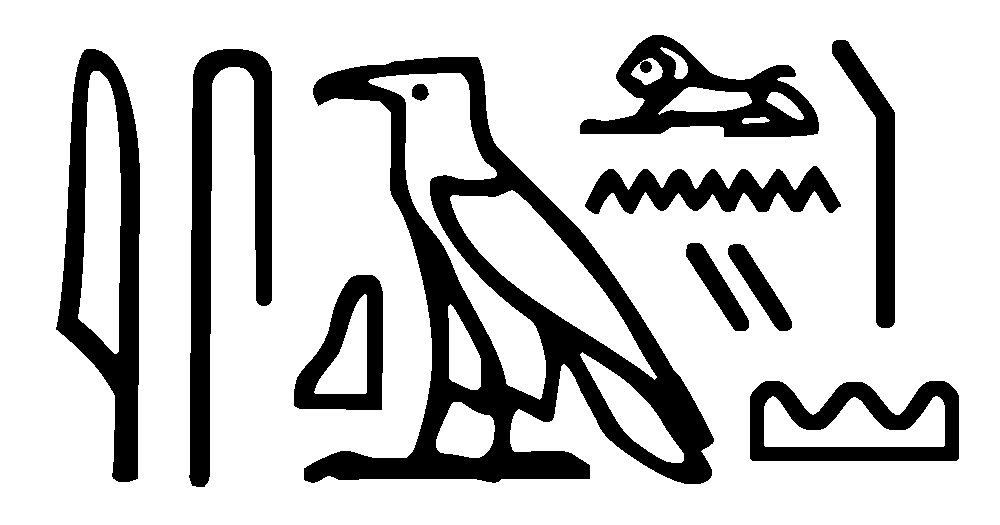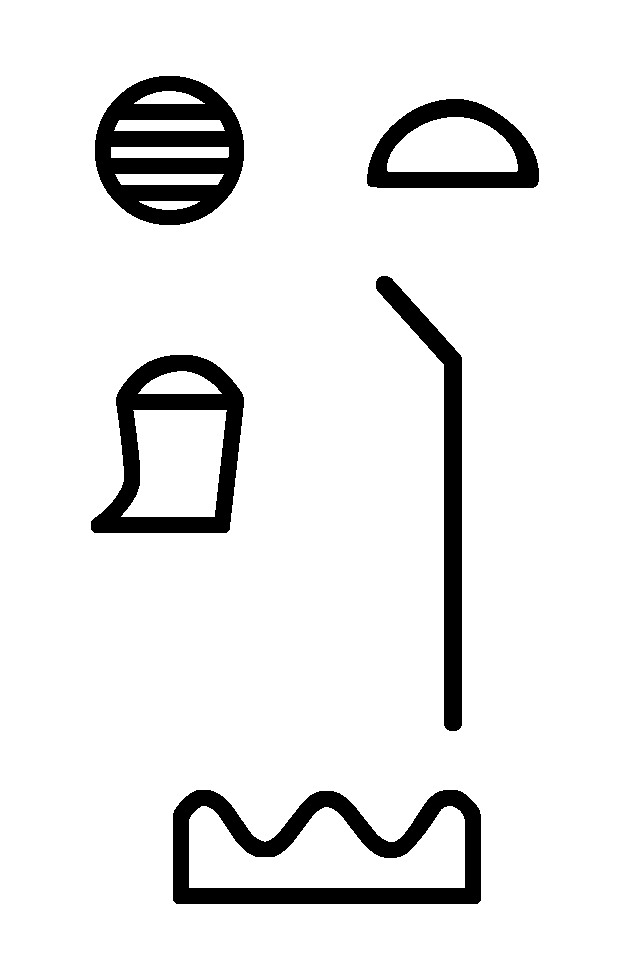𓈉 on:
[Wikipedia]
[Google]
[Amazon]
 The ancient Egyptian Hill-country or "Foreign land" hieroglyph (𓈉) is a member of the sky, earth, and water hieroglyphs. A form of the hieroglyph in color, has a ''green line''-(banding) at the base of the hieroglyph. The hieroglyph refers to the hills, and mountains, on both sides of the
The ancient Egyptian Hill-country or "Foreign land" hieroglyph (𓈉) is a member of the sky, earth, and water hieroglyphs. A form of the hieroglyph in color, has a ''green line''-(banding) at the base of the hieroglyph. The hieroglyph refers to the hills, and mountains, on both sides of the
 The
The
 One major use of the hill-country hieroglyph is as the determinative for land, but especially the names of foreign lands. For example in the
One major use of the hill-country hieroglyph is as the determinative for land, but especially the names of foreign lands. For example in the
File:Darius I statue Parthia.jpg, Parthia (𓊪𓃭𓍘𓇋𓍯𓈉, ''P-rw-t-i- wꜣ''), as one of the 24 subjects of the Achaemenid Empire, in the Egyptian Statue of Darius I.
File:Darius I statue Bactria.jpg, upright=0.5,
Darius I statue Gandhara.jpg,
Darius I statue India.jpg,
File:Scarab of king Tut-E 22807-Egypte louvre 148.jpg, Pharaonic ring
File:KAnana.gif,
''God's Wife of Amun''
 The ancient Egyptian Hill-country or "Foreign land" hieroglyph (𓈉) is a member of the sky, earth, and water hieroglyphs. A form of the hieroglyph in color, has a ''green line''-(banding) at the base of the hieroglyph. The hieroglyph refers to the hills, and mountains, on both sides of the
The ancient Egyptian Hill-country or "Foreign land" hieroglyph (𓈉) is a member of the sky, earth, and water hieroglyphs. A form of the hieroglyph in color, has a ''green line''-(banding) at the base of the hieroglyph. The hieroglyph refers to the hills, and mountains, on both sides of the Nile River
The Nile, , Bohairic , lg, Kiira , Nobiin: Áman Dawū is a major north-flowing river in northeastern Africa. It flows into the Mediterranean Sea. The Nile is the longest river in Africa and has historically been considered the longest riv ...
, and thus the green references the verdant black farming land adjacent to the river proper. It is coded N25 in Gardiner's sign list
Gardiner's Sign List is a list of common Egyptian hieroglyphs compiled by Sir Alan Gardiner. It is considered a standard reference in the study of ancient Egyptian hieroglyphs.
Gardiner lists only the common forms of Egyptian hieroglyphs, but h ...
, and U+13209 in Unicode
Unicode, formally The Unicode Standard,The formal version reference is is an information technology standard for the consistent encoding, representation, and handling of text expressed in most of the world's writing systems. The standard, ...
. It is determinative hieroglyph, simply conveying a meaning, and has no phonetic value.
Various colors, and patterning, may adorn the rest of the hieroglyph when the bottom is green.
Three major uses
 The
The ancient
Ancient history is a time period from the beginning of writing and recorded human history to as far as late antiquity. The span of recorded history is roughly 5,000 years, beginning with the Sumerian cuneiform script. Ancient history cov ...
language
Language is a structured system of communication. The structure of a language is its grammar and the free components are its vocabulary. Languages are the primary means by which humans communicate, and may be conveyed through a variety of ...
hilly land hieroglyph has three major uses:
:1 – hill country, or hills
:2 – a reference to arid, ''desert land''
:3 – Determinative
A determinative, also known as a taxogram or semagram, is an ideogram used to mark semantic categories of words in logographic scripts which helps to disambiguate interpretation. They have no direct counterpart in spoken language, though they may ...
, for foreign lands
The language meaning of the hieroglyph is as an ideogram
An ideogram or ideograph (from Greek "idea" and "to write") is a graphic symbol that represents an idea or concept, independent of any particular language, and specific words or phrases. Some ideograms are comprehensible only by famili ...
or a determinative in the word ''khast'' (khaset), and is often translated as hilly land, desert, foreign land, or district.
Use as determinative
 One major use of the hill-country hieroglyph is as the determinative for land, but especially the names of foreign lands. For example in the
One major use of the hill-country hieroglyph is as the determinative for land, but especially the names of foreign lands. For example in the Merneptah Stele
The Merneptah Stele, also known as the Israel Stele or the Victory Stele of Merneptah, is an inscription by Merneptah, a pharaoh in ancient Egypt who reigned from 1213–1203 BCE. Discovered by Flinders Petrie at Thebes in 1896, it is now ho ...
, foreign lands are mentioned, including the name of Hatti Hatti may refer to
*Hatti (; Assyrian ) in Bronze Age Anatolia:
**the area of Hattusa, roughly delimited by the Halys bend
**the Hattians of the 3rd and 2nd millennia BC
**the Hittites of ''ca'' 1400–1200 BC
**the areas to the west of the Euphr ...
.
Partial list with land determinative
List of uses of the ''foreign land''determinative
A determinative, also known as a taxogram or semagram, is an ideogram used to mark semantic categories of words in logographic scripts which helps to disambiguate interpretation. They have no direct counterpart in spoken language, though they may ...
:
* Ashkelon
Ashkelon or Ashqelon (; Hebrew: , , ; Philistine: ), also known as Ascalon (; Ancient Greek: , ; Arabic: , ), is a coastal city in the Southern District of Israel on the Mediterranean coast, south of Tel Aviv, and north of the border wit ...
* Canaan
Canaan (; Phoenician: 𐤊𐤍𐤏𐤍 – ; he, כְּנַעַן – , in pausa – ; grc-bib, Χανααν – ;The current scholarly edition of the Greek Old Testament spells the word without any accents, cf. Septuaginta : id est Vetus T ...
* Hatti Hatti may refer to
*Hatti (; Assyrian ) in Bronze Age Anatolia:
**the area of Hattusa, roughly delimited by the Halys bend
**the Hattians of the 3rd and 2nd millennia BC
**the Hittites of ''ca'' 1400–1200 BC
**the areas to the west of the Euphr ...
* Retjenu
Retjenu ('' rṯnw; Reṯenu, Retenu''), was an ancient Egyptian name for Canaan and Syria. It covered the region from the Negev Desert north to the Orontes River. The borders of Retjenu shifted with time, but it generally consisted of three reg ...
* Parthia
Parthia ( peo, 𐎱𐎼𐎰𐎺 ''Parθava''; xpr, 𐭐𐭓𐭕𐭅 ''Parθaw''; pal, 𐭯𐭫𐭮𐭥𐭡𐭥 ''Pahlaw'') is a historical region located in northeastern Greater Iran. It was conquered and subjugated by the empire of the Med ...
𓊪𓃭𓍘𓇋𓍯𓈉, ''p-rw-t-i- wꜣ''
* Kingdom of Kush
The Kingdom of Kush (; Egyptian: 𓎡𓄿𓈙 𓈉 ''kꜣš'', Assyrian: ''Kûsi'', in LXX grc, Κυς and Κυσι ; cop, ''Ecōš''; he, כּוּשׁ ''Kūš'') was an ancient kingdom in Nubia, centered along the Nile Valley in wh ...
𓎡𓄿𓈙𓈉, ''kꜣš''
The Nine bows (foreigners or rebels)
One spelling of the foreign peoples, the Nine bows, is represented by the Hill country hieroglyph, ''"t"'', and nine single strokes. The nine foreign lands used for the ''Nine Bows'' are also iconographically shown inside ofcartouche
In Egyptian hieroglyphs, a cartouche is an oval with a line at one end tangent to it, indicating that the text enclosed is a royal name. The first examples of the cartouche are associated with pharaohs at the end of the Third Dynasty, but the f ...
s, with their names. The cartouches are the 'bodies' of the "prisoner", or "captive
Captive or Captives may refer to:
Arts, entertainment, and media Films
* ''Captive'' (1980 film), a sci-fi film, starring Cameron Mitchell and David Ladd
* ''Captive'' (1986 film), a British-French film starring Oliver Reed
* ''Captive'' (1991 ...
", arms tied behind the back, the name of the land/city inside the cartouche.
Canaan
Canaan (; Phoenician: 𐤊𐤍𐤏𐤍 – ; he, כְּנַעַן – , in pausa – ; grc-bib, Χανααν – ;The current scholarly edition of the Greek Old Testament spells the word without any accents, cf. Septuaginta : id est Vetus T ...
-(K-a-n-a-n-a)
File:Sarcophagus of Ankhnesneferibre.jpg, Sarcophagus
A sarcophagus (plural sarcophagi or sarcophaguses) is a box-like funeral receptacle for a corpse, most commonly carved in stone, and usually displayed above ground, though it may also be buried. The word ''sarcophagus'' comes from the Gre ...
inscribed for Ankhnesneferibre
Ankhnesneferibre was an ancient Egyptian princess and priestess during the 26th Dynasty, daughter of pharaoh Psamtik II and his queen Takhuit. She held the positions of Divine Adoratrice of Amun and later God's Wife of Amun between 595 and 525 ...
, Divine Adoratrice of Amun
The Divine Adoratrice of Amun ( Egyptian: '' dwꜣt nṯr n jmn'') was a second title – after God's Wife of Amun – created for the chief priestess of the ancient Egyptian deity Amun. During the first millennium BCE, when the holder of this ...
''God's Wife of Amun''
See also
* Gardiner's Sign List#N. Sky, Earth, Water *List of Egyptian hieroglyphs
The total number of distinct Egyptian hieroglyphs increased over time from several hundred in the Middle Kingdom to several thousand during the Ptolemaic Kingdom.
In 1928/1929 Alan Gardiner published an overview of hieroglyphs, Gardiner's sign ...
References
*Betrò, Maria Carmela. '' Hieroglyphics: The Writings of Ancient Egypt,'' c. 1995, 1996-(English), Abbeville Press Publishers, New York, London, Paris (hardcover, ) *Budge. ''An Egyptian Hieroglyphic Dictionary,'' E.A.Wallace Budge, (Dover Publications), c 1978, (c 1920), Dover edition, 1978. (In two volumes) (softcover, ) Egyptian hieroglyphs: sky-earth-water